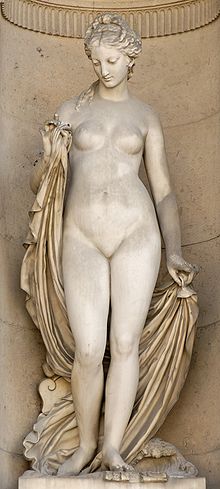Leukothea (mythology)

Leukothea (Greek Λευκοθέα , "white goddess") was the Ino included in the Greek mythology among the sea gods , according to another reading the deified Halia .
myth
Ino and her husband Athamas were the foster parents of Dionysus , the son of Zeus with Semele . The jealous Hera , wife of Zeus, struck Athamas with madness, so that he slew his eldest son Learchus . Ino goes insane with Pseudo-Apollodor and cooks her younger son Melikertes in a cauldron, with which she then jumps off a cliff into the sea. Hyginus Mythographus reports that Ino planned an attack on Phrixus and Helle , the children of Athamas from his first marriage. Athamas, furious with rage, tried to kill Ino and Melikertes, but Dionysus saved his nurse through a fog. Later, Ino threw himself into the sea with Melikertes. Ino and Melikertes are included among the sea gods in all variants. In Ovid's case , it is Venus- Aphrodite (the mother of Harmonia and therefore grandmother of Ino) who asks Poseidon to save the two and transform them into gods.
Pausanias describes the Molurian rock at Megara as the cliff from which Ino jumped into the sea, and the place where she re-entered the country as Leukothea is on the coast of Messenia below the Mathia Mountains. At another point, Pausanias reports the Megarian legend that the body of the Ino was washed ashore near Megara and buried by Kleso and Tauropolis , the daughters of Kleson .
She and her son Melikertes , worshiped as the god of ports under the name of Palaimon , were considered to be benevolent deities of the stormy seas, who gave assistance to the distressed and shipwrecked . An example of this includes the Odyssey , where the shipwrecked Odysseus of Leukothea receives the advice to leave his raft and floating to the shore of Phaiakians -Lands Scheria save. She gives him her veil, which is supposed to protect him from the dangers of the sea.
With the Romans, the Leukothea corresponded to the Mater Matuta .
reception
In a form that goes far beyond the Greek sea deity, the " White Goddess " is treated in the work of the same name by the English poet Robert Graves , published in 1948 . Here the “white goddess” is a universal deity and the mother goddess par excellence. The work had a considerable influence on the New Age movement and neo-pagan religions , especially in the 1960s and 70s . However, the deity Ino / Leukothea and the associated saga circle appear rather marginally in Graves' work.
swell
- Euripides , Medea 1284ff.
- Ovid , Metamorphosen 4, 481ff
literature
- Adolf Schirmer: Leukothea . In: Wilhelm Heinrich Roscher (Hrsg.): Detailed lexicon of Greek and Roman mythology . Volume 2.2, Leipzig 1897, Sp. 2011-2017 ( digitized version ).
- Lewis R. Farnell : Ino-Leukothea. In: The Journal of Hellenic Studies 36, 1916, pp. 36-44.
- Samson Eitrem : Leukothea 1. In: Paulys Realencyclopadie der classischen Antiquity Science (RE). Volume XII, 2, Stuttgart 1925, Col. 2293-2306.
- Ingrid Krauskopf : Leukothea according to the ancient sources. In: files of the colloquium on the subject of "The Goddess of Pyrgi". Tübingen January 16-17, 1979 (= Biblioteca di Studi Etruschi 12). Florence 1981, pp. 137-148 ( digitized version ).
- Jan N. Bremmer : Leukothea. In: The New Pauly (DNP). Volume 7, Metzler, Stuttgart 1999, ISBN 3-476-01477-0 , column 110.
Web links
- Leukothea in the Theoi Project (English)
Individual evidence
- ↑ Diodor , Libraries 5, 55.
- ↑ Libraries of Apollodorus 3, 28.
- ^ Hyginus, Fabulae 2.
- ^ Ovid, Metamorphosen 4, 542ff.
- ↑ Pausanias, Description of Greece 1, 44, 7; 4, 34, 4.
- ^ Pausanias, Description of Greece 1, 42, 7.
- ↑ Homer , Odyssey 5, 333-353; Hyginus, Fabulae 125
- ^ Robert Graves: The White Goddess. A historical grammar of poetic myth. Faber & Faber, London 1948.
